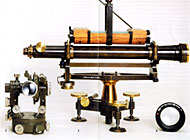Aarau collection recalls renowned Kern company

The Kern Collection in the castle of Aarau is keeping alive the memory of a venerable company and its tradition of fine, optical instruments.
The curator, Heinz Aeschlimann, speaks proudly of the achievements of Kern & Co. Ltd., a leading manufacturer of precision measuring and optical instruments used around the world. The Aarau-based firm, founded in 1819, was closed in 1991.
Two examples of this tradition can be seen outside the single, modestly sized showroom, which houses only a small fraction of the instruments and documents collected.
One example is a massive brass theodolite, an instrument used to measure angles in land surveying, and built for the man described as the father of modern Swiss map-making, General Dufour. The theodolite was delivered to Dufour in 1835 at a cost of SFr 1,600, to which Dufour added another SFr 200 as a token of his gratitude.
Lunar lenses
In the same display case are two camera lenses developed for the 1969 Apollo lunar landing project.
“Kern was famous for its lenses,” said Aeschlimann. “It was renowned as a lens manufacturer for the Paillard camera company, especially in the United States.”
The result was an order from NASA for four lenses.
Aeschlimann was Kern’s sales manager for geodesic land surveying instruments until 1990.
Mixed with his pride is a certain bitterness at what Aeschlimann sees as upper management bungling, which lead to the takeover of the company in the late 1980s by one of its main competitors and its eventual closing.
So the Kern Collection at the city museum in the castle of Aarau is also a shout of defiance by a small group of devotees like Aeschlimann and Franz Haas, former head of personnel at Kern who are intent on keeping the memory of the venerable company, and its tradition of quality and precision alive.
Military instruments
In the 19th century, said Haas, Kern was known in Switzerland and surrounding countries for the production of geometrical compasses and army binoculars. But when the company closed 172 years later, surveying instruments, photogrammetric instruments and defence equipment accounted for nearly 90 per cent of the company’s activities.
“Kern was outstanding in the field of precision measuring instruments for the construction of dams and power stations, nuclear accelerators and tunnels,” said Aeschlimann. “Kern equipment was used in the Gotthard rail tunnel project between around 1872 and 1882 and after that for the Simplon, the Lötschberg and the Albula tunnel projects.”
Haas said customers in the nuclear accelerator field included the Paul Scherrer Institute in Würenlingen in Switzerland, and sites in Berlin, South Africa and England.
Groundbreaking products on display include the most exact distance-measuring instrument, which has a precision of one millimetre for a distance of 100 metres. It was developed in 1971. Another Kern instrument on display is the smallest electronic distance measuring device presented in 1973 at the Chicago convention of the American Congress for Surveying and Mapping.
Treasures in storage
It left Kern’s competitors way behind, said Aeschlimann, “It was a success,” he said. Then with a gentle swipe at Kern management he added, “But perhaps management was not fully convinced of its success. It didn’t seize an opportunity which any other company would have been proud to take.”
The displays in Aarau castle are the proverbial tip of the iceberg. Both Aeschlimann and Haas are reluctant to guess how many items they have in storage, but in 1998, it was estimated that the collection consisted of around 1,700 items including hardware and archives of designs, brochures and reports.
Aeschlimann says one of the difficulties in presenting these items to the public is finding a middle ground that will satisfy the expert with a special interest in the subject and not leave the normal visitor wallowing in incomprehensible technical data.
One goal of the collection is to illustrate the development of the trade and industrial activities of the region.
Haas says the arrival of Jakob Kern on the scene in 1819 and the establishment of his workshop helped move the economy from almost total reliance on the textile industry to something more diversified.
by Paul Sufrin

In compliance with the JTI standards
More: SWI swissinfo.ch certified by the Journalism Trust Initiative
You can find an overview of ongoing debates with our journalists here. Please join us!
If you want to start a conversation about a topic raised in this article or want to report factual errors, email us at english@swissinfo.ch.